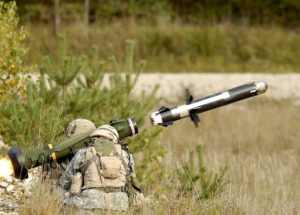Lockheed Martin [LMT] is aiming to nearly double its production capacity for Javelins from 2,100 up to 4,000 per year, a process the company’s chief executive officer said may take “a number of months, maybe even a couple of years.”
Jim Taiclet, CEO of Lockheed Martin, said Sunday during an interview on CBS’
Face the Nation the company is already accelerating internal investment to ramp up Javelin production, as the U.S. continues to send the anti-tank missiles to aid Ukraine in its fight against Russia’s ongoing invasion, while working to ensure its supply chain can support the increased pace of manufacturing the weapon.

“So we’re already investing ahead of time to buy tooling, to expand the plant and also support our suppliers to get ready to ramp up production,” Taiclet said. “We’re starting now to ramp it up because we have an active production line right now that the president saw and also we’ve got a supply chain that’s active in addition to that. So we can start turning up the heat now and ramping up the production immediately because of those circumstances.”
The Pentagon has now officially shifted $1.5 billion to help ramp up production lines and replenish stockpiles of Javelin and Stinger missiles, pulling the funds from the $3.5 billion Ukraine Replacement Transfer Fund appropriated in the $13.6 billion supplemental spending bill for emergency aid to Ukraine passed in mid-March (Defense Daily, May 6).
Following the move, the Pentagon said Friday evening the Army has awarded a $237.9 million deal for Javelin production to Lockheed Martin and Raytheon Technologies [RTX], which jointly manufacture the anti-tank missile.
“We’re planning for the long run, and not just in the Javelin [production] because this situation, the Ukrainian conflict, has highlighted a couple of really important things for us. One is that we need to have superior systems in large enough numbers, so like Javelins, Stingers, advanced cruise missiles, equipment like that. So we know there’s going to be increased demand for those kinds of systems for the U.S. and for our allies as well and beyond into the Asian Pacific most likely too,” Taiclet said.
William LaPlante, the Pentagon’s top acquisition official, said the department’s intent is to eventually replenish stockpiles of equipment sent to Ukraine on a “one-to-one” basis, while officials are considering whether such moves would include replacing F-model Javelins sent to Ukraine with the new G-model of the system.
LaPlante noted that $5.4 billion of the new $33 billion Ukraine aid supplemental request recently delivered to Congress would be for additional efforts to replenish weapons stockpiles (Defense Daily, April 28).
Taiclet was asked about each Javelin requiring 250 microprocessors and challenges with domestic production capacity for such components, with the Lockheed Martin chief responding that Congress passing the Bipartisan Innovation Act to reduce reliance on foreign suppliers would improve the process.
“It will be extremely helpful to have the Bipartisan Innovation Act pass, for example, because we do need to invest more in the infrastructure in the U.S. so we have domestic supply, especially in microprocessors,” Taiclet said.